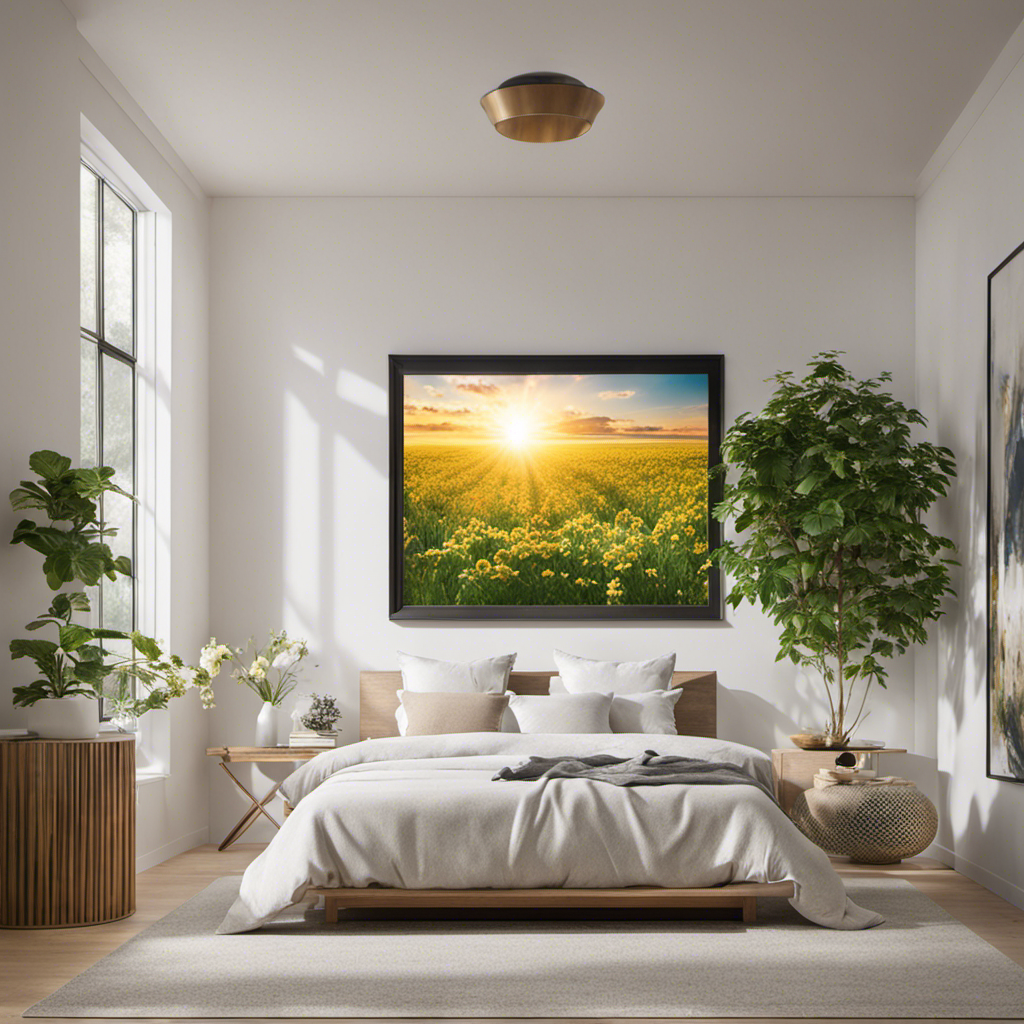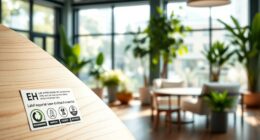As someone who suffers from allergies, I know firsthand the discomfort and frustration they can cause.
Did you know that the average person spends about 90% of their time indoors, where air quality can often be worse than outside?
That’s why understanding the connection between air purifiers and allergies is crucial.
In this article, I’ll share valuable insights on how air purifiers can alleviate allergy symptoms, the different types available, and tips for choosing and maintaining the right one for your needs.
Get ready to breathe easier and enjoy an allergy-friendly indoor environment!
Key Takeaways
- Allergies occur when the immune system reacts to harmless substances known as allergens.
- Air purifiers effectively reduce airborne allergens that can trigger allergies.
- Different types of air purifiers, such as HEPA, activated carbon, and UV-C, offer various benefits for allergy relief.
- Regular maintenance of air purifiers, including filter replacement and cleaning, is crucial for optimal performance.
Understanding Allergies and Their Triggers
Do you know what causes your allergies to flare up? Understanding allergy triggers and common allergens is crucial in managing and preventing allergic reactions.
Allergies occur when the immune system reacts to substances that are harmless to most people. These substances, known as allergens, can be found both indoors and outdoors.
Common allergens include pollen from trees, grasses, and weeds, dust mites, pet dander, mold spores, and certain foods. Each individual may have different triggers, and it’s essential to identify them to effectively manage allergies.
Pollen is a major outdoor allergen that can cause hay fever symptoms, such as sneezing, itching, and a runny nose. Dust mites, on the other hand, are found indoors and can trigger respiratory symptoms, including coughing and wheezing. Pet dander, the tiny particles shed by animals, is another common allergen that can cause allergic reactions in sensitive individuals. Mold spores, which thrive in damp environments, can also trigger allergies and respiratory symptoms.
By understanding the common allergens and triggers specific to you, you can take steps to minimize your exposure. This may include using air purifiers to filter out the allergens, keeping your home clean and dust-free, and avoiding contact with known triggers.
Taking control of your environment can significantly reduce allergic reactions and improve your overall well-being.
How Air Purifiers Can Help Alleviate Allergy Symptoms
Take a closer look at how air purifiers can effectively relieve your allergy symptoms. Air purifiers are highly effective in improving indoor air quality and reducing allergens that can trigger allergies. By filtering out airborne particles, such as pollen, dust mites, pet dander, and mold spores, air purifiers create a healthier environment for allergy sufferers.
The effectiveness of air purifiers can be seen in the benefits they provide. Here is a table outlining some of the key advantages of using an air purifier:
| Benefits of Air Purifiers |
|---|
| Removes airborne allergens |
| Reduces asthma triggers |
| Improves sleep quality |
| Eliminates unpleasant odors |
| Enhances overall respiratory health |
Air purifiers work by using various filtration systems to capture and trap allergens and pollutants. HEPA filters, for example, can remove up to 99.97% of particles as small as 0.3 microns. This includes common allergens like pollen, dust, and pet dander.
In addition to their effectiveness in relieving allergy symptoms, air purifiers also have the added benefit of providing clean air. Breathing clean air can have numerous positive effects on our health, including reducing the risk of respiratory diseases and improving overall well-being.
Different Types of Air Purifiers and Their Benefits
Explore the various types of air purifiers available and discover how each one can benefit you.
When it comes to air purifiers, there are several different types to choose from, each utilizing various filter technologies to clean the air in your home.
One popular type is the HEPA air purifier, which is known for its high efficiency in removing allergens such as dust, pollen, and pet dander.
Another option is the activated carbon air purifier, which is effective in eliminating odors and harmful gases.
UV-C air purifiers, on the other hand, use ultraviolet light to kill germs and bacteria in the air.
It’s important to consider the size of the room you plan to use the air purifier in, as well as the level of energy efficiency it offers.
Some models have adjustable fan speeds and automatic shut-off features, helping you save energy and reduce your carbon footprint.
Choosing the Right Air Purifier for Your Allergy Needs
When it comes to choosing an air purifier for allergies, it is important to consider the type of filter used. HEPA filters are known to be highly effective in capturing allergens such as dust mites, pollen, and pet dander.
Additionally, the size of your room should be taken into account as air purifiers have different coverage capacities.
Lastly, the noise level of the air purifier can impact your overall comfort, so it is advisable to choose a model that operates quietly, especially if you plan to use it in your bedroom or office.
Filter Types for Allergies
You can choose from different filter types to help alleviate your allergies. When it comes to air purifiers, the right filter can make all the difference in the effectiveness of the device. Here are three common filter types that can help you combat allergens:
-
HEPA Filters: These high-efficiency particulate air filters are the gold standard when it comes to capturing airborne allergens. They can trap particles as small as 0.3 microns, effectively removing pollen, dust mites, pet dander, and mold spores from the air.
-
Activated Carbon Filters: These filters are excellent for removing odors and volatile organic compounds (VOCs) from the air. They work by adsorbing these substances onto the carbon surface, resulting in cleaner, fresher air.
-
Electrostatic Filters: These filters use an electric charge to attract and trap particles. They are effective at capturing larger particles like pet hair and lint, but may not be as efficient for smaller allergens.
Choosing the right filter type for your allergies can greatly improve the air quality in your home and provide relief from common allergens.
Room Size Considerations
The size of the room should be taken into consideration when choosing the right filter type for allergy relief. It’s important to understand that the effectiveness of an air purifier is directly affected by the size of the room it is placed in.
A larger room requires a more powerful air purifier with a higher Clean Air Delivery Rate (CADR) to effectively remove allergens. On the other hand, a smaller room may not require a high-powered air purifier and a smaller, more compact unit could suffice.
Common room allergens such as dust mites, pet dander, pollen, and mold spores can be effectively filtered out by choosing the right air purifier for the room size. So, before investing in an air purifier, make sure to consider the size of the room to ensure optimal allergy relief.
Noise Level Impact
It’s important to consider the noise level of an air purifier when choosing the right one for your room. Here are three reasons why silent operation and sleep-friendly features should be top considerations:
-
Peaceful Sleep: A noisy air purifier can disrupt your sleep, making it harder to fall asleep and stay asleep throughout the night. Look for models that offer a silent operation feature, ensuring a restful night’s sleep.
-
Undisturbed Relaxation: Whether you’re reading a book, watching TV, or simply enjoying some quiet time, a noisy air purifier can be a distraction. Opting for a purifier with silent operation allows you to enjoy uninterrupted relaxation in your room.
-
Healthy Environment: Noise pollution can have negative effects on our overall well-being. By choosing an air purifier with sleep-friendly features, you not only improve your indoor air quality but also create a serene environment in your room.
Consider these factors when selecting an air purifier to ensure a peaceful and healthy living space.
Maintaining and Cleaning Your Air Purifier for Optimal Performance
To keep your air purifier working at its best, make sure to regularly clean and maintain it. Proper cleaning and maintenance are essential for optimal performance and longevity of your air purifier.
One of the most important aspects of maintenance is filter replacement. Filters play a crucial role in capturing and trapping airborne particles, allergens, and pollutants. Over time, these filters become clogged and less effective, which can hinder the overall performance of your air purifier.
It is recommended to check your air purifier’s filter regularly and replace it as needed. Most manufacturers provide specific guidelines on when and how to replace the filter, so be sure to follow their recommendations.
In addition to filter replacement, regular cleaning of the air purifier itself is also important. Dust and debris can accumulate on the exterior and internal components, affecting the unit’s efficiency. Wipe down the exterior regularly and clean the internal components according to the manufacturer’s instructions.
Other Allergy-Relief Strategies to Complement Air Purifier Use
As I mentioned earlier, maintaining and cleaning your air purifier is crucial for optimal performance. However, there are other strategies you can incorporate alongside your air purifier to further alleviate your allergies.
Here are some alternative treatments and natural remedies that can help:
-
Essential oils: Certain essential oils, such as lavender, eucalyptus, and peppermint, have properties that can help reduce allergy symptoms. You can diffuse these oils in your home or add a few drops to a carrier oil and apply it to your skin for relief.
-
HEPA vacuum cleaner: In addition to using an air purifier, investing in a HEPA vacuum cleaner can help remove allergens from your carpets, rugs, and upholstery. These vacuums are designed to trap even the tiniest particles, ensuring a cleaner indoor environment.
-
Air filtering plants: Certain indoor plants, like peace lilies, spider plants, and aloe vera, have air-purifying properties and can help remove allergens from the air. Adding these plants to your home can enhance the effectiveness of your air purifier.
By incorporating these alternative treatments and natural remedies, you can enhance the effectiveness of your air purifier and create an allergy-friendly indoor environment.
Now, let’s dive into some expert tips for creating an allergy-friendly indoor environment.
Expert Tips for Creating an Allergy-Friendly Indoor Environment
Now let’s explore some expert tips on how to make your indoor environment more allergy-friendly.
Allergies can be a real pain, but there are ways to minimize their impact on your daily life. One key aspect is choosing allergy-friendly furnishings. Opt for furniture made with hypoallergenic materials, such as leather or microfiber, as they are less likely to harbor allergens like dust mites or pet dander. Additionally, consider investing in dust mite-proof bedding and pillow covers to further reduce allergen exposure while you sleep.
In addition to choosing the right furnishings, there are also natural remedies that can help alleviate allergy symptoms. For example, incorporating indoor plants like aloe vera or peace lilies can help purify the air by removing toxins and allergens. Another natural solution is using essential oils, such as eucalyptus or lavender, in a diffuser to create a calming and allergy-friendly atmosphere.
Maintaining a clean indoor environment is crucial for allergy sufferers. Regularly vacuuming with a HEPA filter and using microfiber cloths for dusting can help remove allergens from surfaces. It’s also important to keep humidity levels in check, as high humidity can promote mold growth. Using a dehumidifier or opening windows to improve ventilation can help prevent mold and mildew.
Frequently Asked Questions
Can Air Purifiers Completely Eliminate All Allergens From My Indoor Environment?
Air purifiers can help reduce allergens in your indoor environment, but they may not completely eliminate them. While they are effective in capturing airborne particles like dust, pollen, and pet dander, they have limitations.
For example, they may not be as effective in eliminating allergens that have settled on surfaces or in fabrics. Additionally, some allergens like mold spores or certain chemicals may require specialized filters or additional treatment methods.
Can Air Purifiers Help With Non-Allergic Respiratory Symptoms Such as Asthma or Bronchitis?
Air purifiers can indeed help with non-allergic respiratory symptoms such as asthma or bronchitis. These devices work by filtering the air and removing harmful particles like dust, pollen, and pet dander. By reducing the presence of these irritants, air purifiers can alleviate symptoms and improve the overall air quality in your home.
Whether you suffer from chronic respiratory conditions or occasional breathing difficulties, using an air purifier can make a noticeable difference in your respiratory health.
How Long Does It Take for an Air Purifier to Show Noticeable Improvement in Allergy Symptoms?
It usually takes a few weeks for an air purifier to show noticeable improvement in allergy symptoms. The effectiveness of air purifiers in reducing allergies depends on various factors, such as the size of the room, the type of allergens present, and the quality of the air purifier itself.
While some people may experience immediate relief, for others, it may take longer to see significant changes. It’s important to choose a high-quality air purifier and follow the manufacturer’s instructions for optimal results.
Are There Any Potential Side Effects or Risks Associated With Using Air Purifiers?
Using air purifiers may come with potential risks and side effects. It is important to be aware of these before considering their use.
Possible side effects include:
- Dryness of the throat, nose, and eyes
- Headaches and dizziness
In rare cases, individuals may experience:
- Worsened respiratory symptoms
- Allergic reactions to the materials used in the air purifier
It is advisable to consult a healthcare professional for personalized advice and to ensure the safe use of air purifiers.
Can Air Purifiers Help With Pet Allergies and Eliminate Pet Dander From the Air?
Air purifiers are a great solution for pet allergies. They effectively eliminate pet dander from the air, providing relief for those who suffer from allergies.
By capturing and trapping the allergens, air purifiers create a cleaner and healthier environment. Say goodbye to sneezing and itchy eyes!
With their advanced filtration systems, air purifiers are a reliable and efficient way to combat pet allergies. You can finally enjoy the company of your furry friends without the discomfort.
Conclusion
So there you have it, folks! Air purifiers are the magical solution to all your allergy woes. Who needs fresh air when you can have purified air, right?
These little machines will surely save you from the horrors of pollen, dust mites, and pet dander. Just sit back, relax, and let the air purifier do all the work. No need to worry about those pesky allergies anymore.
Isn’t it ironic how we’ve become so dependent on technology to solve our natural problems? But hey, who am I to argue with science?
Happy breathing, everyone!




